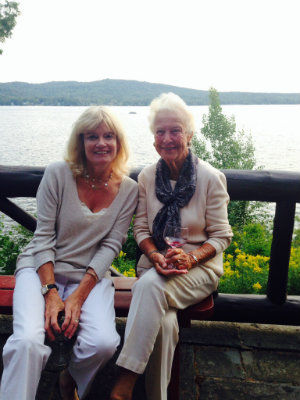In so many ways, we live in the golden age of aging. In the past century, lifespan has doubled. That is one of the greatest, yet underappreciated, accomplishments of modern times. And as more people are living longer than ever before in human history, we are learning more every day about how they can live healthier and happier lives.
My Aunt Mary was a prime example of successful aging. She was the mother of seven children, and when they were grown and her husband died unexpectedly at the young age of 59, she joined the workforce as a teacher’s aide in a school for developmentally disabled children.
She did this for the next three decades. At the age of 90, Aunt Mary decided to “retire” so she would have more time for other things, like bridge, camp, and her wonderful family. At the age of 97, after a busy and happy summer, she died following a brief illness. She was an inspiration for how to live and how to behave.
For her 95th birthday celebration, we all wore T-shirts that said WWAMD? (What Would Aunt Mary Do?)
Many of us have been fortunate enough to know someone like my Aunt Mary. The myriad and vital contributions that older adults make every day enrich our society and culture in ways that are priceless and irreplaceable. So why is it that, from the silver screen and birthday cards to the workplace and, at times, even the doctor’s office, ageism continues to poison the way we think about older adults?
It happens in seemingly lighthearted casual conversation as well as in overtly harmful ways every day. At a time when racist and sexist comments are rightly seen as inappropriate and hurtful by most people, ageist remarks are still not only tolerated, but accepted. We still have some health care professionals who dismiss the pain or illness of certain patients simply because “they’re old, there’s nothing we can do.” And we still have managers and executives in business who discriminate against older job applicants because of preconceived notions about their stamina or skills with technology.
Next year will mark the 50th anniversary of the Age Discrimination Employment Act of 1967, which prohibits discrimination against people 40 and older. Yet, a 2013 survey of 1,502 adults by AARP showed that two-thirds of workers between the ages of 45 and 74 said they have seen or experienced ageism.
The dire consequences for older adults can be seen in a U.S. Bureau of Labor Statistics analysis from 2015, which found that 44.6 percent of people who had been unemployed long term were age 55 or older, compared to 22.1 percent under age 25. Long-term unemployment is defined as 27 or more weeks of joblessness.
At a time when one person in the United States turns 65 every eight seconds, it is unconscionable that the negativity and destructiveness of ageism continues to warp the attitudes and behaviors of so many people and institutions.
Ageism, however, is certainly not just a problem in the United States. October started with the United Nation's International Day of Older Persons 2016 and this year’s theme, appropriately enough, was “Take a Stand Against Ageism.” The World Health Organization analyzed the results of a survey of more than 83,000 people in 57 countries and found that 60 percent of respondents said they believed older people “were not respected.” Those alarming negative attitudes were more prevalent in richer countries, according to the data.
(For more information on global efforts to build a world where older people can lead dignified, active, healthy and secure lives, visit the HelpAGE International website.)
The John A. Hartford Foundation was proud to stand with the World Health Organization in calling on each of us to reflect on our views of aging and older people with an eye toward eradicating negative ageist stereotypes and the painfully real harm they inflict on the lives, health, and well-being of older adults.
This is a moral imperative because we know that, when older adults internalize those negative attitudes, the results can be devastating. Research has shown that older adults who harbor negative attitudes about aging:
- Live 7.5 years less than their peers who positively embrace it.
- Have a decreased will to live.
- Suffer impairment to memory and recovery from illness.
- Experience increased stress.
- Show less interest in living a healthy lifestyle.
We must stand together to make it clear that ageism, like sexism or racism, is unacceptable. That is why The John A. Hartford Foundation joined with eight other funders and eight leading aging organizations to support the Reframing Aging Initiative, which seeks to counter the pervasive negative beliefs about aging that stand as barriers to improving the care of older adults.
The project grew out of discussions in 2012 among representatives of leading aging organizations. In its initial report, Gauging Aging: Mapping the Gaps between Expert and Public Understandings of Aging in America, the FrameWorks Institute found that the way the public views aging and older people differs greatly from the way those of us who have devoted our lives to working in the aging field do.
And one of the key findings was that “the idea of ageism is completely invisible to members of the public … That precludes people from engaging a bigger picture that includes lack of access, lack of opportunity, and institutionalized and structural discrimination against older people,” the report states.
The FrameWorks Institute is now finalizing the second phase of the project, which involves designing and developing empirically tested “reframing” tools to specifically address the gaps in the public’s understanding about aging.
While I firmly believe that we need to respect, value, and celebrate older adults and their many contributions, I also recognize that we have much work to do. Eradicating ageism is a crucial first step. And I ask myself, WWAMD?

